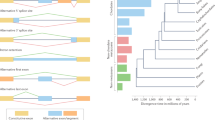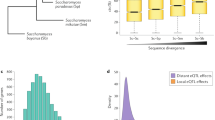Abstract
Gene duplication and alternative splicing are distinct evolutionary mechanisms that provide the raw material for new biological functions. We explored their relationships in human and mouse and found an inverse correlation between the size of a gene's family and its use of alternatively spliced isoforms. A cross-organism analysis suggests that selection for genome-wide genic proliferation might be interchangeably met by either evolutionary mechanism.


Similar content being viewed by others
References
Ohno, S. Evolution by Gene Duplication (Springer, Berlin, 1970).
Hughes, A.L. Proc. R. Soc. Lond. B Biol. Sci. 256, 119–124 (1994).
Lynch, M. & Conery, J.S. Science 290, 1151–1155 (2000).
Brett, D., Pospisil, H., Valcarcel, J., Reich, J. & Bork, P. Nat. Genet. 30, 29–30 (2002).
Modrek, B. & Lee, C.J. Nat. Genet. 34, 177–180 (2003).
Johnson, J.M. et al. Science 302, 2141–2144 (2003).
Makova, K.D. & Li, W.H. Genome Res. 13, 1638–1645 (2003).
Hedges, S.B. Nat. Rev. Genet. 3, 838–849 (2002).
Force, A. et al. Genetics 151, 1531–1545 (1999).
Lister, J.A., Close, J. & Raible, D.W. Dev. Biol. 237, 333–344 (2001).
Kondrashov, F.A. & Koonin, E.V. Hum. Mol. Genet. 10, 2661–2669 (2001).
Letunic, I., Copley, R.R. & Bork, P. Hum. Mol. Genet. 11, 1561–1567 (2002).
Ast, G. Nat. Rev. Genet. 5, 773–782 (2004).
Remm, M., Storm, C.E.V. & Sonnhammer, E.L.L. J. Mol. Biol. 314, 1041–1052 (2001).
Thanaraj, T.A. et al. Nucleic Acids Res. 32, D64–D69 (2004).
Acknowledgements
We thank A. Derti for a critical reading of the manuscript and Y. Groner, E. Domany, M.J. Lercher, A. Bar-Even and S.J. Fleishman for discussions. I.Y. is a Koshland Scholar and D.L. is the incumbent of the Ralph and Lois Silver Chair in Human Genomics. This research is supported by the Crown Human Genome Center, the Abraham and Judith Goldwasser Foundation and the Koshland Center for Basic Research.
Author information
Authors and Affiliations
Corresponding author
Ethics declarations
Competing interests
The authors declare no competing financial interests.
Supplementary information
Supplementary Fig. 1
Independence of relationship with respect to binning. (PDF 95 kb)
Supplementary Fig. 2
Independence of relationship to the number of exons. (PDF 41 kb)
Supplementary Fig. 3
Independence of inverse relationship on the coverage of EST counts per exon. (PDF 92 kb)
Supplementary Fig. 4
Inverse relationship shown on a gene family basis. (PDF 35 kb)
Supplementary Fig. 5
Results for Ensembl delineation of orthologous families. (PDF 54 kb)
Supplementary Fig. 6
Independent estimation of isoform count. (PDF 37 kb)
Supplementary Table 1
Independence of relationship to the number of exons. (PDF 121 kb)
Rights and permissions
About this article
Cite this article
Kopelman, N., Lancet, D. & Yanai, I. Alternative splicing and gene duplication are inversely correlated evolutionary mechanisms. Nat Genet 37, 588–589 (2005). https://doi.org/10.1038/ng1575
Received:
Accepted:
Published:
Issue Date:
DOI: https://doi.org/10.1038/ng1575
- Springer Nature America, Inc.
This article is cited by
-
What puzzle are you in?
Genome Biology (2022)
-
Interplay between gene expression and gene architecture as a consequence of gene and genome duplications: evidence from metabolic genes of Arabidopsis thaliana
Physiology and Molecular Biology of Plants (2022)
-
The divergence of alternative splicing between ohnologs in teleost fishes
BMC Ecology and Evolution (2021)
-
PIC-Me: paralogs and isoforms classifier based on machine-learning approaches
BMC Bioinformatics (2021)
-
The genome of the thin-necked bladder worm Taenia hydatigena reveals evolutionary strategies for helminth survival
Communications Biology (2021)





